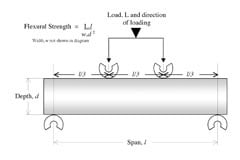The time of tests : Flexural Strength
Led by Europe, more tests are being devised all the time to try to evaluate stone. In this column Barry Hunt explains the tests and discusses what the results show… and what they don’t. This time he looks at flexural strength.
The flexural strength test is potentially more useful than the compressive strength test that I wrote about in this column in April. However, it is not quite as straightforward to undertake because the specimen sizes have to be relatively long in relation to their thickness and obtaining samples can be difficult.
Flexural strength testing is probably best at determining subtle changes in quality, especially in relation to stone orientation, most notably for stones exhibiting laminations or other anisotropic features.
The test essentially involves a rectangular prism of stone being placed on two knife edges or rollers parallel to each other. Either a single knife edge (EN 12372, the three-point test) or a pair of rollers (EN 13161, the four-point test) is then brought down between these supports, causing the test specimen to flex until it fails.
The highest load achieved is used in the calculation of the stone’s flexural strength. The results are typically given in terms of N/mm2 or MPa.
In the United States, the three-point test is covered by ASTM C97 and the four-point test by ASTM C880. These are essentially the same as their European counterparts although the European versions include statistical calculations to determine the ‘lower expected value’, which predicts the natural strength variation.
The Americans provide minimum strength limits for a range of stone types to help guide users, whereas in Europe the producer typically only declares the values obtained. It would be useful if European codes of practice suggested minimum performance requirements.
The test values obtained may vary. For example, the stone might be cut in different directions to any bedding, foliation or other natural features, or samples might be variously wet, dry, partially saturated or at natural moisture content.
Some changes can halve the measured strength compared with the optimal, which might be a highly significant consideration to an engineer or designer where the stone is providing support in a particular orientation within a wet environment.
Because of the thinness of the test specimens, fossils, veins and other discontinuous features can have a dramatic effect on the results, even though such features would have less of an effect in actual use when appearing in larger units.
The four-point test is extremely useful for assessing the effects of discontinuities such as veins and determining optimum slab orientation for cladding panels.
Generally the mean results of the four-point test are around 10% less than those for the three-point test and there is greater variation in results from the four-point test. I prefer the four-point test and I do not believe the three-point test is then necessary as it is almost pointless repetition.
It is important to check that any flexural strength testing has been undertaken in different directions and conditions. If the results do not change much, this typically suggests a consistent material that is sound.
The results of flexural strength testing should not be interpreted in isolation for engineering design unless the value is stated as being the lowest achieved under applicable conditions.
Test values will also alter depending on the number of specimens tested – a greater number provides greater confidence in the results obtained.
Flexural strength testing can provide considerable insight into the quality of any stone material, which is why it is often used to compare specimens before and after they are subjected to cyclic weathering tests. Most notable is frost testing (EN 12371), where a greater than 20% loss in strength is regarded as a failure.
Flexural strength testing is possibly the most critical test that anyone involved with stone should try to understand. Knowing the values that should be achieved under different conditions will get you a long way to selecting an appropriate stone.

